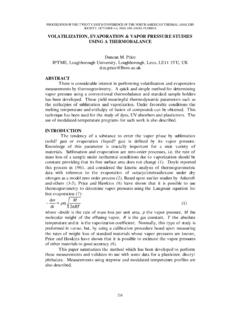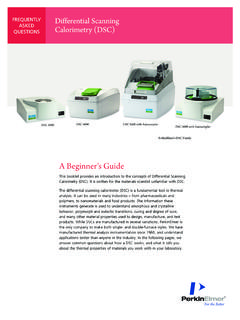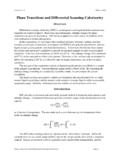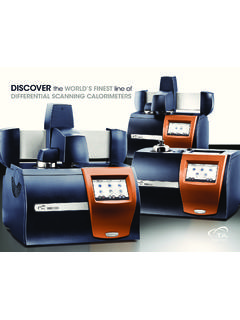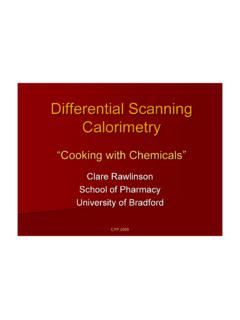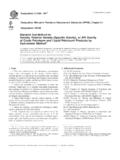Transcription of Temperature calibration of differential scanning …
1 Journal of Thermal Analysis, Vol. 45 (1995) 1285-1296 1995 Akad miai Kiad , BudapestJohn Wiley & Sons, Limited ChicesterTEMPERATURE calibration OF DIFFERENTIALSCANNING CALORIMETERSD. M. PriceCourtaulds Research & Technology, PO Box 111, Lockhurst Lane, COVENTRY CV6 5RS, UK(Received November 30, 1994)AbstractA procedure for calibrating the Temperature scale of a DSC is described. A different calibration trend wasobtained using the transition points of organic compounds compared to that found using the melting points ofhighly pure metals. The crystal-crystal transitions of three ammonium salts were studied by this method;ammonium dihydrogen phosphate and ammonium sulphate were found to be suitable reference materials in theregion -150 to 0 C, but ammonium nitrate was found to be unsuitable due to poorly defined transition pointsand inconsistent thermal :ammonium salts, crystal-crystal transitions, DSC, melting transitions, reproducible behaviour, Temperature calibrationIntroductionDifferential scanning calorimetry (DSC) is probably the most popular thermoanalyticaltechnique within materials science.
2 It partly owes this position to its ability to determineuseful material parameters ( melting point, Tg etc.) rapidly, and with high precision. Theaccuracy of such measurements is dependant on calibration with substances which have well-defined transition temperatures . This is especially important where measurements may becarried out in various laboratories, on different instruments, perhaps over a long period oftime. Suitable experimental procedures have been comprehensively described in the literature[1-3] although the choice of reference materials is still open to debate [4,5].High purity metals exhibit sharp melting peaks by DSC which makes them popular forcalibrating the instrumental response against accurate values determined by classicalcalorimetry.
3 For many practical purposes, this may not be appropriate - when studyingorganic materials, such as high polymers, there is an argument for calibrating "like with like"since there are significant differences in thermal conductivity, heat capacity and transitionenthalpy between metals and organic substances [6]. In addition, some metals are difficult towork with because of their toxicity (mercury) or ease of handling (gallium) and evencommonly-used organic compounds, such as dichloroethane, present problems due toenvironmental issues [7] and volatility. Even so, it is likely that indium, tin, lead, etc. willremain as convenient Temperature (and enthalpy) standards for DSC for the some time use of DSC by the industrial chemist presents a need for "secondary" or "working"standards for DSC calibration .
4 These would have the properties of having one (or more)transition points in the region of most common interest (ca. -100 to 400 C), beinginexpensive, readily available in high purity, easy to handle and presenting little difficulty withtoxicity and disposal. Some of these criteria can be met by existing materials lead has amelting point close to that of poly(tetrafluoroethlyene) and makes a convenient single-pointPRICE: Temperature CALIBRATIONJ. Thermal Anal., 45, 19952temperature (and enthalpy) calibrant for studies on this substance [8] despite oxidising readily. Indium and tin are useful in the intermediate Temperature range, however measurements in theregion below 150 C are problematic since there is little published data on convenient referencematerials which fit the above purposes of this study were therefore threefold; i.
5 To calibrate a DSC instrumentaccording to a recommended procedure [9] using high purity metal standards whose meltingtemperatures represent fixed points in the International Temperature Scale of 1990 [10,11] orits predecessors [12], ii. to explore the use of some low molecular weight organic materials astemperature calibrants, and iii. to investigate the suitability of the phase transitions of readilyavailable inorganic ammonium salts for sub-ambient and medium Temperature calibration [13].MaterialsMercury, gallium, indium, tin, bismuth and lead ( + pure) were obtained fromJohnson-Matthey. Cyclohexane, octane, decane and dodecane were + purity wereobtained from the Aldrich Chemical Co. Benzoic acid ( ), ammonium dihydrogenphosphate, ammonium sulphate and ammonium nitrate (all 98%+ pure) were obtained fromBDH.
6 Freshly distilled water was used direct from the measurements were made with a Mettler DSC-30 heat-flux differential scanningcalorimeter and TC11 controller. Data storage and analysis was performed on a IBM personalcomputer running Mettler GraphWare which displayed transition temperatures to thenearest C. Samples were weighed into aluminium crucibles which had been previouslybaked at 500 C for 30 minutes to establish an inert oxide coating on the container. Metallicsamples were freshly cut and cleaned to remove any existing oxide layer. The crucible wasthen hermetically sealed to minimise interaction with the atmosphere and inhibit evaporation ofthe more volatile materials studied. The crucibles were weighed before and after each seriesof experiments to confirm that no change in mass had taken of the sample's transition Temperature was made by heating the DSC cellfrom 50 C below the onset of the transition (to ensure that the material was in the desiredphase prior to heating) to 30 C above the end of the transition.
7 Each crucible was subjectedto seven heating programmes in the order 10, 10, 1, 2, 5, 20 and 10 C/min, quench-coolingthe cell with liquid nitrogen in-between scans. Even at the highest heating rates employed, thestarting Temperature was sufficiently below the onset of the transition for the DSC cell to havereached steady-state heating conditions. The effect of cooling rate on the transitions of theammonium salts was also examined in which case the samples were re-heated at 2 C/min. TheDSC cell was purged with dry nitrogen (flow rate: 20 ml/min) and care was taken to seal thebase of the instrument to prevent the ingress of air along the leads to the starting this work the cell had been calibrated according to the manufacturer'sinstructions. For the purposes of this study, the response of the instrument was deliberatelyaltered by removing the optional nickel liner that had protected the furnace wall againstoxidation at high : Temperature CALIBRATIONJ.
8 Thermal Anal., 45, 19953 Results and discussionTransition temperatures were taken as the extrapolated onset Temperature (Te) for theendothermic peak in the DSC response [3]. This was determined by constructing two straightlines on the DSC curve; the first being an extrapolation of the linear portion of the DSC curve5-10 C below the start of the process, and the second line being drawn as a tangent thesteepest part of the leading edge of the peak (Fig. 1). The intercept of these two linesdefined example of one of the difficulties encountered during this work is shown in Fig. 2. Afresh sample of gallium was encapsulated in an aluminium crucible which had not beenrendered sufficiently passive by baking at high Temperature . Over a series of temperaturecycles, a layer of gallium-aluminium alloy developed at the sample-crucible interface whichproduced a double melting peak [14].
9 It was for this reason that each set of experimentsbegan and ended with heating scans at 10 C/min - any discrepancy between the initial and finalvalues of Te indicated a problem with the sample ( interaction with the crucible, oxidation,loss of material etc.) and the results were effect of thermal lag was accounted for by plotting Te as a function of heating rate ( )and determining the effective transition Temperature as the heating rate tended to zero( Te( 0) ) by a simple least-squares linear regression according to the expression:Te( ) = s. + Te( 0)where Te( ) is the experimental value of the extrapolated onset Temperature at heating rate ( C/min), is the heating rate, s and Te( 0) are the slope and intercept of the Te( ) vs. plot values for Te( 0) and s for the metallic and organic materials are given intable 1 with the corresponding literature values for the transition Temperature (Tt).
10 Note thatcyclohexane undergoes a crystal-crystal transition at C [15] which was also measured. In all cases the temperatures have been rounded to the nearest C since this was the degreeof precision afforded by the computer software. The standard errors in the regression analysisused to determine Te( 0) and s were less than C and min difference between the true transition Temperature and the observed transitiontemperature (?Tcorr( 0) = Tt - Te( 0) ) is plotted against Te( 0) in Fig. 3. For clarity,transitions corresponding to the melting temperatures of the metallic and organic materialshave been distinguished, as has the crystal transition of cyclohexane. A solid and a dashedstraight line depicts the general trend observed for the two categories of samples.



